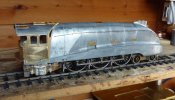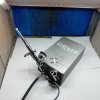John TAYLOR
Western Thunderer
The only real issue I have, which you are in the process of addressing, is the adhesion to brass. I have so far stayed with an aerosol of self-etch primer, then sprayed on top.
Watching with interest.
Yes John, like you I`ve always done the same with brass and have relied on Closterman rattle can etch primer but recently have tried Upol in a failed attempt to escape the new style spray can nozzles which are now predominantly fan cap design to give an enormous wide and flat spray angle that gives very awkward coverage on model loco`s.
I have forgotten to mention that this whole enterprise of mine was influenced by Hatchette`s O Gauge Build The Mallard Partwork Kit.
As many will know , all the brass and alloy parts were sprayed with a lacquer primer so that anyone out in the non modelling world could assemble the kit entirely with superglue.
I have built this kit as a soldered construction and I can tell you that the lacquer primer was a s*d to remove easily . After a lot of experimentation ,including my wife`s nail varnish remover, it turned out to be Wilko`s paint remover that stole the show in removing the lacquer without destroying the many delicate parts...... and that needed at least one hour of soaking.
.... and so, I`m hoping to emulate the effect on brass.....

Last edited:































